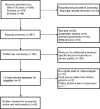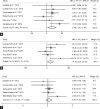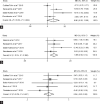The effect of healthy dietary patterns on male semen quality: a systematic review and meta-analysis
- PMID: 35915543
- PMCID: PMC9491032
- DOI: 10.4103/aja202252
The effect of healthy dietary patterns on male semen quality: a systematic review and meta-analysis
Abstract
The incidence of infertility has recently risen. Semen quality is an important male fertility indicator, and dietary factors can affect semen quality. We conducted this systematic review and meta-analysis to determine the effects of healthy dietary patterns on semen quality. A literature search was conducted in 3 databases (Embase, Web of Science and PubMed) on August 21, 2021. The included cross-sectional studies examined the influence of the Mediterranean, Dietary Approaches to Stop Hypertension (DASH), and prudent diet patterns on semen quality parameters; six studies (1244 subjects) were included. By comparing high consumption with low consumption of healthy dietary patterns, the results of the meta-analysis showed significantly higher sperm concentrations (mean difference [MD] = 6.88 × 106 ml-1, 95% confidence interval [CI]: 1.26 × 106 ml-1-12.49 × 106 ml-1; P < 0.05), a significant increase in total sperm count (MD = 16.70 × 106, 95% CI: 2.37 × 106-31.03 × 106; P < 0.05), and a significant increase in progressive sperm motility (MD = 5.85%, 95% CI: 2.59%-9.12%; P < 0.01). The sperm concentration, progressive sperm motility, and total sperm count were significantly higher in men with higher versus lower consumption of healthy dietary patterns. However, the results must be interpreted with caution.
Keywords: cross-sectional study; healthy dietary pattern; meta-analysis; semen quality; systematic review.
Conflict of interest statement
None
Figures



Similar articles
-
Association between adherence to the Mediterranean diet and semen quality parameters in male partners of couples attempting fertility.Hum Reprod. 2017 Jan;32(1):215-222. doi: 10.1093/humrep/dew288. Epub 2016 Nov 14. Hum Reprod. 2017. PMID: 27994040
-
Dietary patterns are positively associated with semen quality.Fertil Steril. 2018 May;109(5):809-816. doi: 10.1016/j.fertnstert.2018.01.010. Fertil Steril. 2018. PMID: 29778381
-
Association of the Dietary Approaches to Stop Hypertension, Physical Activity, and Their Combination with Semen Quality: A Cross-Sectional Study.Nutrients. 2019 Dec 22;12(1):39. doi: 10.3390/nu12010039. Nutrients. 2019. PMID: 31877862 Free PMC article.
-
The impact of vegetarian diet on sperm quality, sex hormone levels and fertility: a systematic review and meta-analysis.J Hum Nutr Diet. 2024 Feb;37(1):57-78. doi: 10.1111/jhn.13230. Epub 2023 Sep 18. J Hum Nutr Diet. 2024. PMID: 37581238
-
Temporal trends in sperm count: a systematic review and meta-regression analysis of samples collected globally in the 20th and 21st centuries.Hum Reprod Update. 2023 Mar 1;29(2):157-176. doi: 10.1093/humupd/dmac035. Hum Reprod Update. 2023. PMID: 36377604
Cited by
-
Healthy and unhealthy dietary patterns and sperm quality from the Led-Fertyl study.Andrology. 2025 Sep;13(6):1408-1419. doi: 10.1111/andr.13789. Epub 2024 Oct 24. Andrology. 2025. PMID: 39449282 Free PMC article.
-
Role of Mediterranean diet in endocrine diseases: a joint overview by the endocrinologist and the nutritionist.J Endocrinol Invest. 2024 Jan;47(1):17-33. doi: 10.1007/s40618-023-02169-2. Epub 2023 Sep 11. J Endocrinol Invest. 2024. PMID: 37697017 Free PMC article. Review.
-
Short-term diet intervention comprising of olive oil, vitamin D, and omega-3 fatty acids alters the small non-coding RNA (sncRNA) landscape of human sperm.Sci Rep. 2025 Mar 5;15(1):7790. doi: 10.1038/s41598-024-83653-4. Sci Rep. 2025. PMID: 40044751 Free PMC article.
-
Effects of Calorie Restriction on Preserving Male Fertility Particularly in a State of Obesity.Curr Obes Rep. 2024 Jun;13(2):256-274. doi: 10.1007/s13679-024-00557-0. Epub 2024 Mar 15. Curr Obes Rep. 2024. PMID: 38489002 Review.
-
The effects of mediterranean and Persian diet on sexual function and semen parameters quality among infertile men: a randomized controlled trial.Sci Rep. 2025 Jul 1;15(1):21656. doi: 10.1038/s41598-025-98985-y. Sci Rep. 2025. PMID: 40593139 Free PMC article. Clinical Trial.
References
-
- Boivin J, Bunting L, Collins JA, Nygren KG. International estimates of infertility prevalence and treatment-seeking: potential need and demand for infertility medical care. Hum Reprod. 2007;22:1506–12. - PubMed
-
- Inhorn MC, Patrizio P. Infertility around the globe: new thinking on gender, reproductive technologies and global movements in the 21st century. Hum Reprod Update. 2015;21:411–26. - PubMed
-
- Dyer SJ, Abrahams N, Hoffman M, van der Spuy ZM. 'Men leave me as I cannot have children': women's experiences with involuntary childlessness. Hum Reprod. 2002;17:1663–8. - PubMed
-
- Kobori Y. Home testing for male factor infertility: a review of current options. Fertil Steril. 2019;111:864–70. - PubMed
-
- Huang C, Li B, Xu K, Liu D, Hu J, et al. Decline in semen quality among 30,636 young Chinese men from 2001 to 2015. Fertil Steril. 2017;107:83–8.e2. - PubMed
Publication types
MeSH terms
LinkOut - more resources
Full Text Sources
Medical

